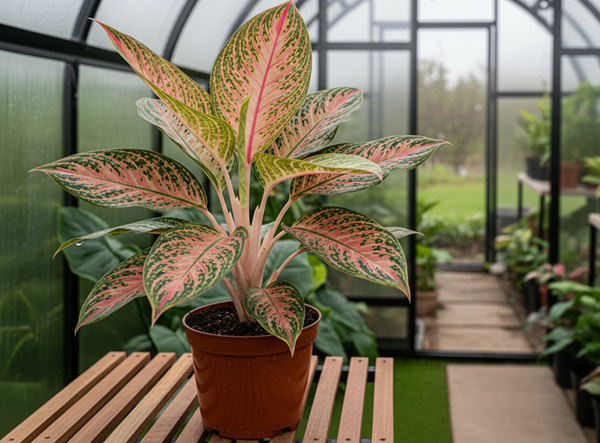
Name: Aglaeonema spp.
Common Names: Chinese Evergreens, Phillipine Evergreen, Red Aglaonema
Light Needs: Low (even dark).
Best Temperatures: Warm, 65ºF (18ºC) nights to 85ºF (29ºC) days.
Water and Humidity Needs: Keep just moist and use unchlorinated water or allow tap water to sit in the open overnight before using. Provide extra humidity.
Growing Guidelines: Use a peat-based mix. Repot when plant looks tired which is normally within 2 years.
Common Problems: Brown leaf edges indicate dry air, bad drainage, or too much minerals or salts from tap water. Leaf variegation fades in too much light. Mealybugs can hide at leaf bases.
Propagation: Stem cuttings by dividing the stalks, or air layer at any time.
More Good Stuff about Chinese Evergreens
Aglaonema is a genus of about 40 species of foliage plants in the family Araceae, native to the tropical swamps and rainforests of southeastern Asia from Bangladesh east to the Philippines and north to southern China. It is known to be poisonous to dogs, cats and horses.
Pruning
The need to prune this plant depends on the look you want it to have. No pruning is even necessary if you prefer a low maintenance approach. Just allow it to grow and remove dead leaves as needed. If you would prefer to keep the plant compact, you can do this by cutting back the plant as necessary.
Chinese Evergreens naturally grow upward, but you can encourage it to grow in an outward direction by continually cutting the leaves back. This will result in a bushier-looking Chinese Evergreen as the plant directs its energy toward growing new leaves where the old ones were cut, instead of putting energy into growing the main stems.
How to Deal with Yellow Leaves
Yellowing leaves are usually a result of overwatering. Test the soil of your plant before you water it, and only proceed if the top layer of soil is dry. This plant doesn’t like to sit in constantly moist soil and should recover well when allowed to go a little dry between waterings.
If you have not been overwatering your plant, then yellow leaves could point to a copper deficiency. This is a very copper thirsty plant, and so copper deficiency is a common problem with the Chinese Evergreen. To ensure it is getting the nutrients it requires, fertilize it at half the recommended strength every month throughout the growing season, every other month during autumn, and not at all during winter. You should also repot the plant as needed, where it will benefit from nutrients in the fresh soil.
How to Deal with Brown Tips on Leaves
Browning leaf tips in this plant are usually caused by a buildup of unwanted minerals, such as fluoride from tap water. Being a fluoride-sensitive plant, water it with distilled water or water collected from the rain if your local water supply is heavy in fluoride. If the buildup of minerals in your soil from past watering is the issue, repot your plant in fresh soil and continue watering in low fluoride or fluoride-free water.




Comment here